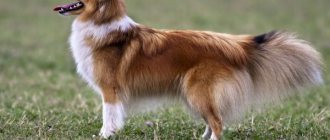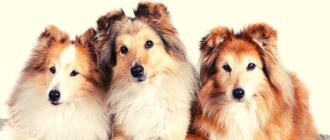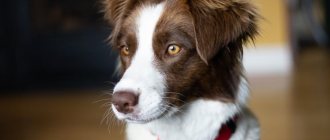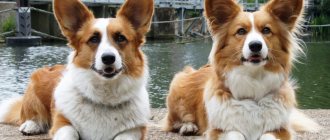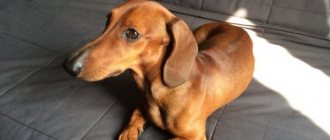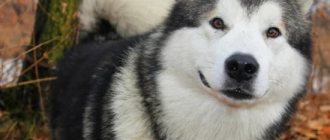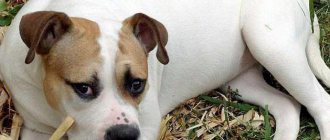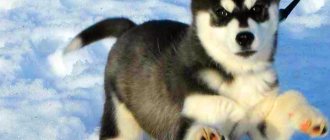Caucasian Shepherd Dogs are one of the oldest breeds, descended from Molossians. This is one of the largest dogs with a recognizable appearance, reminiscent of a fluffy bear. The breed was originally bred for guard and herding work. Due to its fearless, decisive character and powerful physique, it is also called a wolfhound.
- Features of the structure of the head
- Features of education and training
- Health
History of the Caucasian Shepherd Dog breed
Caucasian Shepherd Dog
Caucasian Shepherd Dogs are among the oldest dog “clans”, the history of which dates back thousands of years. For example, the ancestors of today's wolfhounds grazed sheep flocks in the foothills of the Caucasus long before the advent of Christianity. As for the origin of the breed itself, its founders are considered to be the Tibetan Great Danes, which in Ancient China were used for baiting and fighting. Some experts call the homeland of dogs southwestern Asia, or more precisely, the Urartu-Ararat kingdom, where the animals were in the service of cattle breeders and from where they began to disperse across adjacent territories.
An interesting fact: the first “breeders” to whom Caucasian Shepherds owe their outstanding guard instinct were ancient shepherds. It was they who were in charge of breeding animals and selecting puppies, cultivating and successfully developing useful performance characteristics in them. For example, a real shepherd dog, in the understanding of Caucasian shepherds, had to have endurance and sufficient strength to deal with an attacking wolf. In addition, she was prescribed unpretentiousness in food and insensitivity to sudden changes in air temperature.
The impetus for the appearance of shaggy “highlanders” in tsarist Russia was the Caucasian War. Participants in the hostilities brought dogs as living trophies, but none of the newly minted shepherd dog owners had any desire to seriously engage in breeding the breed. Domestic breeders began to take an interest in wolfhounds only in the 30s of the last century, after the Nuremberg Exhibition, but their breeding research was interrupted by the Second World War, which destroyed the entire gene pool of Caucasians. It was possible to more or less restore the breed in the USSR only in the early 70s. Around this time, consumer demand for Caucasian Shepherds began to grow.
Appearance of the Caucasian Shepherd
What Caucasian Shepherd Dogs cannot be blamed for is the lack of charisma and external charm. Indeed, the muscular “highlanders” look very respectable, if not monumental. Long-haired individuals with lush, almost bear-like “fur coats” look especially colorful, giving the animals a resemblance to gigantic toys.
The minimum weight of a purebred male Caucasian wolfhound is 50 kg. However, most dogs do not stop at such modest figures, often breaking the bar of 70 and sometimes 100 kg. Shepherd females are shorter and slimmer than males: the minimum permissible weight for a girl is 45 kg, with a height of 64 cm. But, as with any rule, there are exceptions here too.
Head
Caucasian Shepherd puppies
Wedge-shaped, with a flat forehead and prominent cheekbones. The Caucasian Shepherd's skull looks massive, but the brow ridges and occipital protuberance of representatives of this breed are weakly expressed. The muzzle is wide, gradually tapers from the base to the nose and ends with a strong chin. The stop is noticeable, but without a sharp transition.
Lips
Dry, fleshy, with good pigmentation.
Teeth
Massive, white, incisors are located tightly to each other. Both scissor and straight bite types are acceptable. It is desirable to have a full set of teeth (42).
Nose
Caucasian Shepherd with a person
The bridge of the nose is smooth, wide, with a large lobe that does not extend beyond the muzzle. The nostrils are opened moderately. Ideally, the lobe should be black, but for individuals with piebald and spotted coat colors, an exception can be made.
Eyes
Caucasian Shepherds have round eyes, located slightly obliquely and at a fairly large distance from each other. Representatives of this breed have an attentive, focused, appraising gaze. The iris colors specified by the breed standard are all shades of brown, including dark brown and light hazel variants.
Ears
Small, hanging type and high set. The ear flap is densely muscular with the inner part pressed to the head. Both cropped and natural ear shapes are acceptable.
Neck
Short, dense, with a developed scruff.
Frame
The body of the Caucasian Shepherd is large, elongated, with a wide back, short loin and tucked belly. The croup is slightly rounded, elongated, with a slight slope at the base of the tail. The chest is deep and noticeably extended in breadth.
Muzzle of a Caucasian Shepherd dog
Tail
Crescent-shaped, set high. In a calm animal, it hangs down, reaching the hocks; in an excited animal, it is raised above the line of the back.
Limbs
The front and rear legs are placed level. Wide shoulder blades, pressed to the body, turn into strong, muscular shoulders. The pasterns are large and short. The hips of Caucasian Shepherds are strong and “pumped up”. The hock joints are dry, wide and strong. The paws of all four limbs are large, arched, with toes compressed into a ball.
Wool
Satisfied Caucasian man
Coarse hair, noticeably lagging behind the body, with a pronounced undercoat. The average length of the awn and undercoat is 5 cm. On the ears, the hair forms funny tassels, and in the chest area it turns into a chic mane. On the back of the front paws, the hair gathers into long feathers; the dog’s hips are hidden under soft downy “pants.” The tail is heavily covered with hair, making it appear thicker than it actually is. Depending on the length and structure of the coat, three types of Caucasian wolfhounds are distinguished:
- smooth-haired;
- long-haired;
- intermediate.
Among buyers, individuals of the second type are in high demand. Of the entire tribe of Caucasian Shepherd Dogs, they are the ones who have the most striking and memorable appearance. Representatives of the first variety are easily confused with Alabai due to their short undercoat and similar build.
Color
All types of piebald, solid and spotted colors are accepted, with the exception of any combination of black.
Possible defects
Caucasian Shepherd Dogs are considered defective if their anatomical features do not fit into the official standard. An animal may be disqualified from competition if it has the following developmental defects:
- cryptorchidism;
- lack of height (dwarfism);
- non-standard bite;
- brown-brown color and any variations thereof;
- blue and black coat colors, as well as any combinations thereof;
- docked tail;
- blue or grayish tint to the eyelids, earlobes and lips;
- entropy;
- eyes of different shades, as well as uneven color;
- absence of one or more teeth (exceptions: third molars and first premolars);
- brown tint to eyelids, lips and nose.
Time to go home
Having chosen a puppy, you don’t need to drag him home right away. It is best to make several visits to your pet so that he can get used to you and you can examine him carefully. Perhaps you didn’t notice something when you first met.
Caucasian Shepherd puppies are taken no earlier than forty-five days. Until this time, the baby still has a connection with his mother and a sudden change of environment will be a great stress for him. But no later than two and a half months, since early socialization in a new environment is very important for dogs of this breed.
Before you take your puppy home, the breeder should instruct you on vaccinations, deworming, and any necessary future medical care. He is also obliged to tell you what the baby ate in the nursery, and what food may not have suited him.
Did our article help you? Tell us in the comments how you chose the puppy.
Please share this article with your friends and like it.
Photo of an adult Caucasian Shepherd dog
Personality of the Caucasian Shepherd
Having a rather pleasant and sometimes downright touching appearance, Caucasian wolfhounds remain very serious pets, the owners of which will have to constantly keep their finger on the pulse. These severe brutals are focused on protecting people and their property. No stranger, even one with the most insinuating manners, will be able to gain their trust. Intimidation and treats also have no effect on dogs, so if you are looking for a first-class watchman with the makings of a professional bodyguard, the brave “highlanders” will not disappoint you.
Caucasian Shepherd with owner
Caucasian Shepherd Dogs “thaw” slightly only when they are in the circle of their loved ones, which is generally not surprising. Endless devotion to home and family is one of the key characteristics of this dog breed. True, in order to earn the pet’s trust, you will have to work hard on the image of a strict and fair owner, since the cult of strength for shaggy “security” is not an empty phrase.
Most Caucasian Shepherds are smart, balanced and quite adequate pets, with a tempered character. For example, they willingly spend time with children, taking part in their games and pranks. However, do not try to train a shaggy guard into an all-forgiving nanny: a shepherd’s job is to protect a person, and not serve as amusement.
Despite the natural harshness, “Caucasians” are not averse to sharing the territory with some domestic animals. As for living with other dogs, the best company for a shepherd dog will be a representative of any of the decorative breeds. The miniature dimensions of a four-legged creature are a kind of guarantee of peaceful coexistence of pets, while in a larger individual the Caucasian wolfhound will immediately sense a rival, whom it will try to crush under itself.
Breed traits
Breed traits (on a 5-point scale)
| Caucasian Shepherd Dog | |||
| Activity | in the house | 3 | |
| on the street | 4 | ||
| Obedience | training | 1.9 | |
| strangers | 1 | ||
| Domination | in family | 2.9 | |
| over dogs | 3.4 | ||
| Defending your territory | from people | 3.8 | |
| from dogs | 3.9 | ||
| Sociability | in family | 3.5 | |
| with strangers | 1.2 | ||
| with dogs | 1.5 | ||
| Concentration | in family | 3 | |
| in front of strangers | 2 | ||
| with dogs | 2 | ||
| Aggressiveness | in family | 2 | |
| to strangers | 5 | ||
| to the dogs | 4.5 | ||
| to cats | 2.8 | ||
| Family behavior | calmness | 2 | |
| demand for affection | 2 | ||
| excitability | 3.1 | ||
| playfulness | 1.9 | ||
| excessive barking | 2 | ||
| behavioral breakdowns | 2.6 | ||
| Tolerance for children | up to 4 years | 1.5 | |
| over 4 years old | 1.6 | ||
| Institutional use | watchman | 4.8 | |
| bodyguard | 4.9 | ||
This breed is often compared to the following dog breeds: German Shepherd, Saint Bernard, Leonberger, Rottweiler, Newfoundland.
The Caucasian Shepherd is considered aggressive and angry, but with proper training it is a loyal, affectionate and obedient pet. Although it is difficult to cope with this independent and stubborn animal. Therefore, before getting a dog of this breed, you need to study its characteristics, the pros and cons of keeping it, and reviews from the owners.
The photographs show what a Caucasian Shepherd looks like:
Education and training
There are many myths about the bloodthirsty nature of Caucasian Shepherds.
It is important to understand that no dog is born a killer. But he could very well become one as a result of improper upbringing. An owner who neglects the training and socialization of a pet and does not know how to maintain his own authority risks raising an uncontrollable and ferocious creature, which he will eventually have to part with. In addition, when bringing a small puppy into the house, not every buyer is aware of who this cutie will transform into in a year. Please note that as they grow up, Caucasian wolfhounds completely get rid of their “childish” character traits, turning into self-confident and rather stubborn guards. The upbringing and socialization of a puppy begins from the very first days of its appearance in the house. Particular attention should be paid to individuals living in the city. A dog should not be afraid of public transport, growl at every passerby and chase stray cats. Since Caucasian Shepherd Dogs are a slow-maturing breed, they begin to be taught their first commands at the age of 5-6 months. By the age of one year, the animal should understand and execute the following commands:
- “You can’t!”, “Ugh!”;
- “Sit!”, “Stand!”, “Lie down!”;
- "Near!";
- "Teeth!";
- "Muzzle!";
- "Place!";
- "To me!".
Training a Caucasian Shepherd Dog
The Caucasian Shepherd is a personality dog, so do not try to persuade him to uselessly run after a thrown ball or plate. Such activities cause the animal to feel bewildered: why waste energy if it can be saved for a possible attack on the enemy? Caucasian wolfhounds are prevented from completely immersing themselves in the learning process due to their innate stubbornness and high level of intelligence. Surprising as it may seem, a truly effective method of training shaggy “highlanders” has not yet been invented. Moreover, with them, even the standard OKD (General Training Course) gives very inexpressive results.
The qualities that the owner of a Caucasian Shepherd will need in the process of training a pet are patience and endurance. In addition, it is necessary to establish close emotional contact with the animal, since representatives of this breed are distinguished by developed intuition and can easily determine the owner’s mood by his facial expressions and voice. Don’t be surprised, but training a Caucasian Shepherd can take 2-3 years due to the dog’s dislike of repetition. And the point here is not the complexity of nature. The animal simply does not see the point in monotonously repeating the same exercise, because it is much more reasonable to save energy for more interesting activities.
Do not be fooled by the advice of “experienced” dog lovers who claim that Caucasian Shepherd dogs need to be beaten periodically so that they understand who is “boss” in the house. You will achieve nothing but anger and uncontrollable aggression this way. Yes, it is necessary to treat your pet strictly, and sometimes quite harshly, but applying corporal punishment to it is the last thing. Bribery with treats and affection in a particular case is also not suitable. A shepherd is not a vulnerable lapdog and does not need your indulgences.
Like most dogs of large breeds, Caucasian wolfhounds have a tendency to dominate, so it is important to catch the moment when the animal begins to show leadership habits in order to further correct its behavior. It’s not difficult to understand that your pet has gained strength and is preparing to dominate the household. Usually such a dog begins to neglect the rules of etiquette: begging for food; run into the house ahead of the owner; when walking on a leash, break free and drag the person along with you. Some individuals demonstrate aggression by growling at family members.
Specifics of training the Caucasian Shepherd Dog ZKS
Caucasian Shepherd Dog on the training ground
No matter what the advertising of cynological schools promises, ZKS courses for the Caucasian Shepherd Dog are purely a formality. These stern giants are born watchmen and bodyguards, and they do not need to be taught the correct reaction to any “alien” who has violated the boundaries of their master’s domain. If you still want your dog to learn the intricacies of protective guard service, be prepared for the fact that during training your pet will not always demonstrate brilliant results. So, for example, an animal can simply ignore a provocation from a trainer, and this behavior can be explained simply: the dog does not see the need to resist the fake threat.
Ideally, ZKS training is carried out on the territory that the pet considers its own. Training on playgrounds and vacant lots disorients the dog. The animal does not understand why it should guard an uninteresting and completely unfamiliar place that does not belong to it. In addition, many of the skills taught in the ZKS course are contrary to the nature of Caucasian Shepherds. In particular, most wolfhounds do not pursue an enemy who has fled, but protective guard service requires the opposite from the animal.
Caucasian Shepherds also do not like to practice skills on a sleeve stuffed with cotton wool, preferring to bite into open areas of the instructor’s body, which is why many dog handlers do not undertake to work with the breed. Wolfhounds do not grab a troublemaker who has encroached on the health of the owner or his property with their teeth, but completely tear them, and it will take titanic efforts to wean them from this habit. At exhibition competitions, dogs can also be cunning and turn on energy saving mode. Such half-hearted work indicates that the animal has managed to appreciate the frivolity of what is happening and does not consider it necessary to give all its best for the sake of some kind of assessments.
Hey! Is there anything to protect? What if I find it?
The right places
To choose a truly Caucasian Shepherd puppy, you first need to determine where exactly you will buy it. Shops, bird markets, and just private advertisements in newspapers or the Internet - now you can find a bunch of offers for the sale of puppies. But they will not give any guarantee that your fluffy ball will definitely turn into a purebred Caucasian Shepherd Dog, and even physically and mentally healthy.
Therefore, do not be fooled by beautiful words and low prices, cast aside any doubts - feel free to start visiting specialized nurseries and official clubs. You can also visit exhibitions, where you always have the opportunity to communicate with breeders and get good advice from them on where you can choose a wonderful specimen of the Caucasian Shepherd breed.
Don't forget to check the breed standard. Especially if this is your first time encountering a Caucasian Shepherd. This knowledge will help you determine whether the puppy you choose fits certain parameters inherent in this particular breed. This is even more important if you are going to perform with your pet at exhibitions where judges thoroughly examine the participants.
Before visiting the kennel, make sure in advance that it is officially registered with the Russian Cynological Federation (RKF). A certificate of registration can only be obtained by a nursery whose owner has passed certification for permission to breed.
But choosing a nursery is only half the battle. Now you need to talk to the breeder. He should not only talk to you calmly, leaving a pleasant impression, but also competently answer all your questions. Ideally, the breeder should give you a tour of his “domain”, show you the closest relatives or parents of the offspring on which you have focused your attention.
Don’t be shy – ask the breeder in detail about the advantages and disadvantages of the puppy’s parents. In response, you should hear the truth, confirmed by the necessary documents: medical certificates, passed tests to determine articular dysplasia (Caucasian Shepherd dogs, due to their large mass, are prone to these diseases), pedigree.
There must be the necessary documents for each puppy: a birth certificate, a medical passport, a certificate of examination of the puppies for signs corresponding to the breed. All puppies approximately one month old must be branded or microchipped.
If the breeder refuses to provide such information, tries to evade direct answers, and does not provide all the documents, it means that he is trying to hide something from you. In this case, it is better to choose another place to purchase a Caucasian Shepherd puppy.
In addition to productive communication with the breeder, you need to carefully familiarize yourself with the conditions in which the puppies are kept. A separate spacious place should be allocated for the offspring (either a huge enclosure with a roof, or a fence and canopy), the total area of which is divided into sectors:
- for sleep and rest;
- for eating;
- for the toilet;
- for games and walks.
Everything must be kept clean, the toilet must be cleaned on time and be as dry as possible, the presence of toys is a big plus, which speaks of the caring attitude of the owner towards the offspring. Availability of clean water is a must. Try to wait until the moment they start feeding the puppies - a conscientious breeder will not skimp on either the quantity or quality of food.
Care and maintenance
The Caucasian wolfhound is a terrible owner who is truly happy only when he has something to protect. Accordingly, the best home for a pet would be a cottage with a courtyard and land. These shaggy brutals are not sensitive to temperature changes, so they feel quite comfortable in a spacious enclosure. Keeping Caucasian Shepherd dogs on a chain is also quite acceptable, but it should be a light chain up to 2.5 m long.
Moving a “Caucasian” into a city apartment is an extreme sport for a very amateur, practiced only by the most stubborn lovers of the breed. Yes, shaggy guards do not suffer from hyperactivity and do not cause pogroms, but they cannot fully realize their security qualities in such conditions. The difficulties with placing a pet should not be discounted. The Caucasian Shepherd is a large breed and its representatives require plenty of space. It is not enough to provide the dog with a spacious bed and a food bowl; it is also necessary to provide an excellent overview of the room entrusted to it. In addition, when opening the door to each guest, the owner will have to carefully monitor the reaction of his pet: a stranger who has crossed the threshold of private property is enemy No. 1 for shaggy bodyguards.
Hygiene
Fluffy handsome man
You don't have to be a cynology guru to understand that long-haired Caucasian Shepherds require more careful care than their short-haired counterparts. The soft hair of shaggy individuals becomes tangled, and in winter it absorbs snow moisture, so long-haired wolfhounds are periodically combed and trimmed (the hair on the legs and paws is shortened). Shepherd dogs are washed as needed, for example, when the animal gets dirty in the mud or has acquired blood-sucking “tenants.” At the same time, it is better not to deny dogs swimming in open waters, especially since they are excellent swimmers.
In spring and summer, “Caucasians” suffer from ear mites, so ear specula need to be inspected and cleaned more often in the warm season. If your pet is shaking its head and scratching its ears, contact your veterinarian to investigate the problem. Perhaps it is not mites that are to blame, but otitis media.
The eyes of Caucasian Shepherds are problem-free, but some individuals have a congenital pathology in the form of a loose eyelid. As a result, an infection from outside gets into the eyes, causing inflammation. You can combat the problem with chamomile decoction or veterinary drops.
“Caucasians” like to chew bones and even wooden boards in their spare time, the remains of which get stuck between their teeth. So buy tweezers in advance, which you will use to free your pet’s jaws from solid particles of food and wood. You can remove plaque, which periodically appears in every dog, with a special brush and veterinary paste.
Ear cropping
Previously, the ears of Caucasian Shepherd dogs were subject to mandatory cropping. The procedure was not carried out for aesthetic purposes. In this way, ancient breeders tried to protect their pets from blood loss, because the longer the ear, the greater the risk of injury to the animal in a fight. Today this requirement has been lifted, but for old times’ sake, most nurseries continue to practice this surgical operation.
Caucasian Shepherd with cropped ears
The ideal age for ear cropping of a Caucasian wolfhound is the first days of life. On the 5th day after birth, the ear tissue thickens, and working with it becomes more difficult and dangerous, as there is a risk of blood loss. Owners who have purchased a puppy with normal ears, but would like to have them cropped, should wait until the dog is one year old. At this age, the animal is able to tolerate general anesthesia, under which the procedure is usually performed.
Important: do not play the know-it-all doctor and do not try to trim the Caucasian Shepherd’s ears yourself. Each animal has a unique shape, thickness and size of the ear, so only a veterinarian or an experienced breeder can determine the principle of “cutting” for this part of the body.
Walk
Of course, it is necessary to walk “Caucasians”, but spending half a day with them on the street is not at all necessary. Please note that shaggy security guards are not happy with promenades that are too long, since they prefer to save their energy for more serious matters. In crowded places, in veterinary clinics and public transport, a muzzle is required. Dogs do not like this accessory, so it is better to accustom pets to it from puppyhood. To go out into the world, the Caucasian Shepherd will need two leashes: a short one (from 1 to 1.5 m) to keep the animal at the owner’s feet, and a long one for the actual walking.
Rules for walking a Caucasian Shepherd dog
- The dog is taken outside only on a short leash and wearing a muzzle.
- Walking Caucasian Shepherd dogs by children under the age of 14, as well as by persons under the influence of drugs and alcohol, is strictly prohibited.
- If an animal is walking in a private fenced area, passers-by must be notified about this. A suitable sign would be: “Beware, evil dog!”, attached at the entrance to the territory.
Feeding
Compared to representatives of other large breeds, Caucasian Shepherds are small dogs. 35-45 g of natural food or 10-15 g of “drying” per kilogram of animal weight - this is the daily food consumption rate for an adult. Shepherd dogs have a high metabolism, which allows them to “squeeze” the maximum nutrients from a relatively small portion. In addition, their digestive system perfectly absorbs milk, a product that can cause intestinal upset in most dogs. Here, however, it is worth making an explanation: only those individuals who have been accustomed to it are able to digest whole milk. If such food did not appear on the dog’s “table” for several months, and then unexpectedly returned, get ready for diarrhea.
Nutrition of the Caucasian Shepherd
The most important product in the diet of the Caucasian Shepherd is meat, and its coarse varieties: horse meat, lean beef, lamb. By-products and fish (mackerel, horse mackerel) are also not excluded. Animal proteins should be diluted with cereal porridges, as well as fruits and vegetables. Cereals (mainly rice and buckwheat) must be thoroughly boiled, otherwise the dog’s stomach will not be able to handle them. You can prepare cottage cheese for your pet: heat a liter of milk on the stove and when boiling add 4 tbsp. l. calcium chloride. Apple and carrot salads with added butter and banana puree are suitable as vitamin supplements.
Caucasian Shepherd Dogs are not picky when it comes to food and willingly absorb everything that their owner gives them. Experts recommend not accustoming your dog to a particular variety of food and delicacies, since representatives of this breed use energy extremely sparingly and do not always have the opportunity to “burn” extra calories. So if your pet begins to suffer from loss of appetite, do not be alarmed and do not try to force feed him. The dog just decided to have a fasting day, thus getting rid of excess energy reserves.
Health and diseases of Caucasian Shepherd dogs
Caucasian Shepherd Dogs are a healthy and hardy breed with good immunity. Of the genetic diseases, only hip dysplasia and optic nerve atrophy seriously plague them. Slightly less frequently, dogs are diagnosed with bursitis and degenerative myelopathy. One should not discount viral infections, to which individuals kept in open-air cages are especially susceptible.
Due to a sedentary lifestyle and lack of exercise, many older animals gain excess fat, which ultimately leads to diabetes. Lack of physical activity can play a bad joke on the Caucasian Shepherd’s joints, triggering the development of arthritis.
Different sellers - different prices
A dog is sold very cheaply by random people who first bought it and then realized that they couldn’t cope. It is not recommended to buy such a pet if you have big plans for it. The time spent with the previous owners will subsequently make itself felt if:
- the owner did not care about his upbringing;
- fed incorrectly;
- was rude to him, because of which the dog became nervous and harbored a grudge;
- overly spoiled my four-legged friend.
When making a purchase from a nursery, you are guaranteed to receive a puppy from elite parents, with documents. Private traders can make fake papers.
How to choose a puppy
Immediately decide who exactly you need: a pet, a watchman and bodyguard, or a future successor to the line of Caucasian Shepherd Dogs. If you are planning to take an animal into a home where there are children, it is better to opt for females who are more good-natured and more willing to learn. But keep in mind that “for health” the girl will have to be allowed to have offspring at least once.
Caucasian Shepherd at an exhibition
Caucasian Shepherd dogs make excellent guards. But since boys have a more domineering character, it is easier for them to dominate an inexperienced owner. So, before you settle a shaggy male brutalist in your house, think carefully about whether you have enough endurance and strength to raise him to be a protector and not a ferocious aggressor.
When choosing a future watchman for the nursery, pay attention to his behavior. Active and sociable puppies have maximum potential. Cocky and pugnacious children grow into wayward leaders, whose temper can only be curbed by a strict owner. Remember about the puppy's health. Animals that have been kept under proper conditions should not show signs of inguinal or umbilical hernias. Cropped ears and the absence of dewclaws are signs that the breeder is responsible for his occupation and monitors the health of his charges.
Note: you can check the condition of a Caucasian Shepherd puppy with a simple test. Bring a piece of raw meat to the dog’s nose - a healthy pet will react to this action with lightning speed and try to grab the treat.
Why do you need a dog?
Before purchasing a Caucasian Shepherd puppy, you must determine for yourself why exactly you need it. This will determine how much money you will pay for it. All puppies can be divided into three classes according to their purpose. Let's look at each class in detail.
The first category of dogs is called the pet class - domestic dogs. The exterior of such animals is of an average level; minor defects may be present. For example, non-standard color or different-colored eyes. But it is imperative to check such pets for the presence of hereditary diseases and mental disorders. Safety comes first.
Remember, puppies of Caucasian “nationality” are not sofa dogs, but formidable defenders. Therefore, they are not suitable for the role of pets that sit forever idle and wait for food. Such pets are bought only as a watchman and family friend, and they must be trained.
A Caucasian Shepherd of this class is relatively inexpensive compared to other classes. In Russia, you will pay from three hundred to five hundred dollars for such a puppy.
The second category of dogs is called the breeding class - breeding producers of offspring. Their appearance, mental and physical condition must be at the highest level. Moreover, females will cost more than males, since they can make good money on them.
You can buy a breed-class puppy in the price range from six hundred to eight hundred dollars, according to Russian offers.
The third, highest category of dogs is called show class - exhibition specimens. Such dogs have an ideal exterior, and you can’t find fault with their behavior. Puppies of this class are not born as often as babies of other classes, because the birth of such a baby is a huge success. Not every breeder will agree to sell a promising puppy.
Accordingly, such a pet costs as much as possible by Russian standards: from nine hundred to one thousand two hundred dollars, or even more.
Remember that, like dogs from the first category, breed and show class puppies also need to be raised and trained in a timely manner, and not just deal with the area for which you are purchasing a pet.
Of course, parents of offspring with an excellent pedigree, excellent show scores, ideal external and mental characteristics are huge advantages. But no breeder will give you a guarantee that the puppy you choose will also become a champion. Everything will depend only on your constant participation in the development of your pet.

